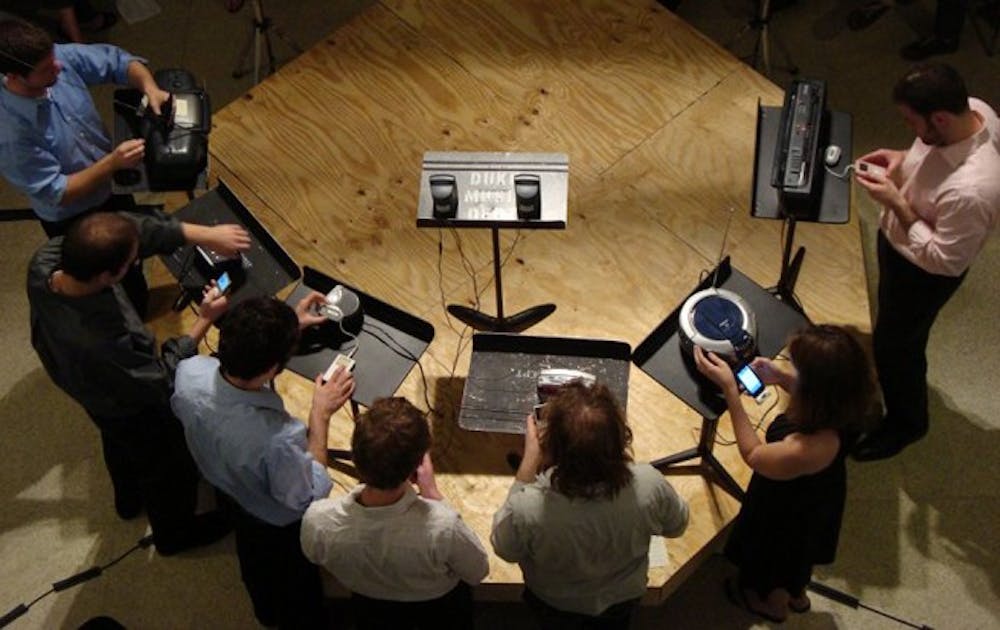The term “cover” is hardly ever used for art forms outside of popular music. It seems silly, after all, to call something like photo artist Sherrie Levine’s 1980 Untitled (After Walker Evans) series—replicas of Walker Evans’ Depression-era photography—a “cover” of Evans’ original work. Visual art, like Levine’s, is more friendly to terms like “appropriation”; theater and dance often employ “reinterpretation” or “revision.”
This Sunday, the Duke New Music Ensemble ([dnme]) shows another side of the “cover,” one with both flexibility and nuance, in their evening-length concert appropriately titled “Music for Covers Only.” The show features seven recent popular songs—originally recorded by artists such as Beyoncé, Lil Wayne, Lady Gaga and even the creators of the Auto-Tuned “Bed Intruder” YouTube ditty—all re-interpreted and re-composed by Duke graduate students.
[dnme] was created in 2007 to allow music graduate students to play and compose contemporary music. The group is, as current director and graduate student in music composition Tim Hambourger said, “a chance [for students] to play with each other, to be performers and composers all at the same time” outside their normal curricular work. Sunday’s show is a direct response to [dnme]’s first covers-only concert that was coordinated with The Record exhibition at the Nasher in 2010. Hambourger noted the enthusiasm surrounding that show from audience and Ensemble members alike.
“I overheard conversations with three or four different people who said things like, ‘looking back on it, I would’ve totally loved to cover this!’” he recalled. “Having it be pretty contemporary and keeping everything pretty recognizable was our second take on this [cover] idea and we can focus in a little more, with more of a tight-knit theme.”
This time around, all of the pieces are drawn from the past decade, though they vary widely in genre and structure. On the one hand, there’s Beyoncé’s “Single Ladies (Put a Ring on It)” (re-titled “If You Like It Then You Shoulda…”), from which Hambourger extracted the bridge and turned it into “this long upright bass solo that turns into this funky 1970s guitar and keyboard groove.” On the other hand, there’s Radiohead’s “Myxomatosis” (now “Xotamymosis”), which already pounds with an almost hostile, gritty bass line. Fellow composition student and bassist/keyboardist Vladimir Smirnov’s response was to up the distortion and frenzied drumming on the track. The piece concludes—Hambourger says “melt[s] away”—with a synthesized string arrangement.
“Bed Intruder Song,” the YouTube phenomenon widely known by the central phrase “hide your kids, hide your wife” and that Jamie Keesecker interpreted for this show, seems like an outlier. After all, it’s not a hit by Top-40 standards—but, then again, neither is “Myxomatosis.” In this way, Keesecker’s choice speaks to the increasingly internet-based manner in which we acquire and play music in the 21st century. But it also represents Keesecker’s unironic interest in the song’s musicality.
“It seemed like just the right time to remind people how good of a song it is,” Keesecker said. “My arrangement starts pretty basic and…plays in a very recognizable way. Halfway through, it starts to change and it goes through some different moods, these little tangents.”
Hambourger pinpointed “Bed Intruder Song” as indicative of the pleasures of mainstream pop culture.
“I’m thinking of Jamie’s cover and the part [in which the Auto-Tune plays], ‘You are so dumb, so dumb,’” Hambourger reflected. “You hear that part of the song in the beautiful flute melody. It cracks me up. You hear pitches you recognize but they’ve been completely warped and it’s hilarious.”
Suqi Huang, a first-year student and the only undergraduate currently playing in [dnme], said that while “Mil”—a cover of Lil Wayne’s “A Milli”—is the most challenging melody-wise, “Bed Intruder Song” is easier for her violin training.
“It’s fun to play because the video itself is hilarious,” she added.
Huang was enticed to join [dnme] partly as a result of her experience at the North Carolina Governor’s School, the six-week state-funded residential program begun by Terry Sanford in 1963. Huang, who attended for instrumental music, was taken out of her comfort zone when she encountered musical improvisation for the first time as part of the school’s focus on contemporary artistic and intellectual ideas.
In addition to [dnme], Huang plays with both the Duke Symphony Orchestra and Duke Chamber Players and takes a quartet class. During the Duke Arts Festival she performed with a quartet in Perkins Library.
“Each of [these groups] has a different dynamic. In [dnme] we don’t have that much of an obvious leader. In general, we have to listen to each other. Without a conductor giving us tempo, we have to do it ourselves, which makes it more challenging,” Huang said.
Keesecker and Hambourger both compared [dnme]’s unique structure in “Music for Covers Only” to that of a band. It’s a metaphor that will be especially fitting when the Ensemble takes their show to Motorco Music Hall in December after their Bone Hall performance this weekend.
The use of both venues reflects [dnme]’s open-endedness. While the members of [dnme] are unsure of their next project, they’re excited to bring their collection of covers to both Duke and Durham.
“The Ensemble really gives us a chance to show the rest of the community things we’re really interested in at the moment and things that make us excited,” Keesecker said. “I feel like it’s our way to contribute our voice to the collective music scene.”
[dnme] presents “Music for Covers Only” this Sunday in Bone Hall and Thursday, Dec. 6 at Motorco Music Hall. Both shows start at 8 p.m.
Updated 11/9/2012, 12:30 a.m.:
The final lines of this article in the print edition and previous online version incorrectly stated the date of [dnme]'s performance as being this Saturday, Nov. 10. The performances are, in fact, this Sunday, Nov. 11 in Bone Hall and Thursday, Dec. 6 at Motorco Music Hall.
Get The Chronicle straight to your inbox
Signup for our weekly newsletter. Cancel at any time.

